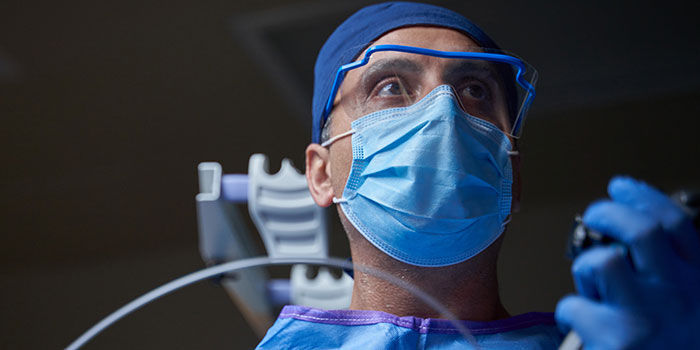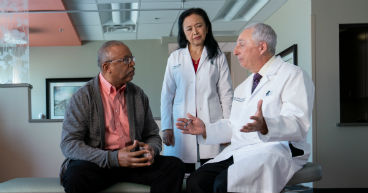
Cancer. It’s one word. But Cancer isn’t one disease, it’s hundreds of disease types and subtypes that may physically affect our bones, brains, breasts or any and all of the organs in the body. And no two cancer patients experience the disease the same way, even if they’ve been diagnosed with the same type of cancer.
Indeed, the disease is so complex, so vast in its impact, it can’t be described, addressed or summed up in the six letters that spell the word cancer. Even the list of symptoms, risk factors and potential carcinogens may be overwhelming and complex.
But knowledge is power. So, learning more about the cancer may help you and your loved ones and caregivers better confront a diagnosis head on. And learning more about risk factors may help you prevent the disease in the first place.
Scores of websites, blogs and resources are available online to help patients educated themselves about cancer, its causes and treatments. Tens of thousands of readers have clicked on CancerCenter.com links and the CancerCenter360® blog to delve into a wide variety of cancer-related subjects.
In this article, we’ll look at the diverse topics that make up the year’s most-clicked CancerCenter360 blogs. Headlines include:
- When to worry about low lymphocytes
- What’s the difference? Benign vs. malignant tumors
- When to worry about colon polyps
- What’s driving the improvement in U.S. cancer survival rates?
- How to file for Social Security disability benefits if you have cancer
- Why are cancer rates rising in adults under 50?
- How quickly does cancer spread?
- Does doxorubicin deserve its ‘red devil’ reputation?
- Power lines and cancer: Is there a connection?
- How to return to an active sex life after prostate cancer
If you’ve been diagnosed with cancer and are interested in a second opinion on your diagnosis and treatment plan, call us or chat online with a member of our team.
When to worry about low lymphocytes
Doctors learn a lot about your health when they order blood work. The tests may tell whether you’re at risk for diabetes or heart disease, your kidneys and liver are healthy, or if you have a healthy immune system.
Low lymphocytes may be caused by any number of conditions, including cancer. And while the cause of low lymphocytes isn’t typically serious, talking to your doctor about what your level indicates and which next steps you should take may help put your mind at ease.
This blog article explores multiple topics, including the symptoms of low lymphocytes and what you should do if your lymphocytes are low.
Learn more about low lymphocytes
What’s the difference? Benign vs. malignant tumors
There’s no such thing as a good tumor. These masses of mutated and dysfunctional cells may cause pain and disfigurement, invade organs and, potentially, spread throughout the body. But not all tumors are malignant, or cancerous, and not all are aggressive.
While it may seem easy to categorize benign tumors as harmless and malignant tumors as harmful, the distinctions are often more of a gray area. Yet the importance of differentiating the two is critical.
This blog explores the key differences between benign and malignant tumors and how doctors know if a tumor is cancerous.
Learn more about benign vs. malignant tumors

When to worry about colon polyps
If you recently underwent a colonoscopy, your doctor may have had to remove some colon polyps. Polyps are often harmless, but some may be precancerous or increase your risk of developing colon cancer in the future. That’s why it’s important to understand what colon polyps are, what symptoms they cause, how doctors treat them and when you should be concerned about them.
To help you recognize the symptoms of colon polyps and understand the cancer risks they may pose, this article answers some frequently asked questions, including:
- What causes polyps in the colon?
- Do certain foods cause polyps in the colon?
- Which types of colon polyps are cancerous?
- How fast do colon polyps grow back?
Learn when to worry about colon polyps
What’s driving the improvement in U.S. cancer survival rates?
Over the past 30 years, the United States has celebrated a string of cancer success stories, including a declining rate of new cancer cases and better outcomes for those diagnosed with the disease.
The country’s cancer death rate has declined 33 percent since 1991, thanks largely to cancer research that has led to new treatments, gains in screening and early cancer detection, a sharp decline in tobacco use and a better understanding of risk factors.
This article looks more deeply into why cancer rates in the U.S. are down 33 percent. It also addresses issues in racial disparities and how breast cancer and prostate cancer rates are still rising.
Learn what’s behind the improvement in cancer survival rates
How to file for Social Security disability benefits if you have cancer
Living with cancer may mean you aren’t able to perform some of the activities you enjoyed in the past, and this may even require taking a break from your job. In certain cases, you may be eligible for government disability benefits, so it’s important to know how to file for those, which disability benefits may be available to you and how much disability programs pay to qualified applicants.
This article focuses on government Social Security Disability Insurance benefits, administered through the Social Security Administration, specifically for cancer patients. We’ll explain the eligibility criteria, how to file for these benefits, what to expect if you do qualify and how to appeal a negative decision.
Learn how to file for Social Security disability benefits if you have cancer
Why are cancer rates rising in adults under 50?
One of the most common risk factors for cancer is something we can’t do anything about—age. Our cancer risk increases as we get older, with the average age at diagnosis hovering around 68.
But a new study in Nature Reviews Clinical Oncology says that over the last few decades, doctors have been seeing dramatic increases in cancer in adults younger than 50. The disturbing trend has scientists searching for:
- Reasons behind the sharp increase in early-onset cancer
- How best to screen for or detect cancers in young adults
- Whether the common cancers in older adults differ from the types that strike younger people
- Which treatments show promise for younger people
This article delves into what’s causing cancer rates to rise in people under 50, specific risk factors that may affect young adults and how people under 50 reduce their cancer risk.
Learn why cancer rates are rising among people under 50
How quickly does cancer spread?
Every cancer is different, so there’s no universal rate at which all cancers grow. Some cancers tend to remain in place and not grow much at all. Others grow slowly—so slowly that they may never require treatment. Various factors, including the cancer’s stage and grade (how abnormal the cancer cells look under a microscope), may affect whether and how each cancer grows and spreads.
This article explains which cancers spread quickly and what impacts the speed of cancer development.
Learn how quickly cancer spreads
Does doxorubicin deserve its ‘red devil’ reputation?
Chemotherapy is widely known to cause difficult side effects in most cancer patients, including hair loss, an increased risk of infection, nausea and vomiting. But one particular drug, doxorubicin, is so powerful and may produce such intense side effects it is named for Satan himself, and not just because of its bright red color.
The drug is commonly called the “red devil chemo” both because of its distinctive color and because it can cause serious side effects, including potential heart damage, in some individuals.
This blog explores what to expect from so-called red devil chemo and how to better manage its side effects.
Learn more about red devil chemo
Power lines and cancer: Is there a connection?
Many homebuyers—especially those with young children—may quickly eliminate from consideration houses near high-voltage power lines, because they fear the lines will increase cancer risk and threaten their families’ health in other ways.
The concern with high-voltage lines, which carry electrical energy over long distances, is the strong electromagnetic fields (EMFs) they produce. Some researchers suspect (but haven’t been able to produce the evidence to confirm) that individuals with significant exposure to these fields may be at increased risk of cancer.
In this article looks at what the research says about power lines and cancer risk and what you can do if you are concerned about nearby powerlines.
Learn about power lines and cancer
How to return to an active sex life after prostate cancer
No matter the cancer type, treatments often cause side effects that affect patients’ quality of life. But with prostate cancer, the potential side effects may be particularly concerning to men who are trying to decide which approach is right for them.
Prostate cancer treatments often impact a patient’s sex life. Surgery, radiation therapy and other treatments may cause side effects like low sex drive, loss of penis length, dry orgasm, low sperm count and/or erectile dysfunction. Yet experts say most of these side effects are manageable, and many men have a strong chance of returning to a healthy sex life after prostate cancer treatment.
To help you understand the potential impacts and side effects of prostate cancer treatment, this article explores the options available for patients to help regain their sexual health and vitality.
Learn how to return to an active sex life after prostate cancer
If you’ve been diagnosed with cancer and are interested in a second opinion on your diagnosis and treatment plan, call us or chat online with a member of our team.



